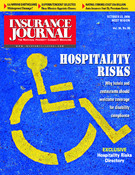In 2005, the private passenger auto insurance industry lost $16.2 billion because of premium rating error, according to San Francisco-based Quality Planning Corp.’s annual Premium Rating Error report. Data showed premium rating error represented 9.9 percent of the $163 billion revenue recognized by personal auto insurance premiums industry-wide. That figure indicates insurance companies are missing opportunities to capture significant revenue, the report noted.
Dr. Daniel Finnegan, founder and president of QPC, said, “For the average auto insurer, each percent of rating error loss translates into a 20 percent reduction in profitability. An insurer that reins in these losses through stringent data integrity measures can increase profits significantly.”
QPC’s Premium Rating Error report was based on premium audit reviews of more than 18 million private passenger auto policies from 20 major carriers. The report distinguished the difference between vehicle rating errors (mileage, usage, type of vehicle and location) and driver rating errors (driving experience and driving record), and showed how each contributed to overall premium rating error.
In 2005, driver rating-errors rose to $8.7 billion from $8.5 billion in 2004, largely because of an increase in unrated operators. The report showed flaws in vehicle rating factors such as commute distance, annual mileage, vehicle usage and territory contributed to the increase. It appeared many errors were due to not keeping up with policyholders’ lifestyle changes.
“All of these rating errors can be controlled and reduced by insurers willing to adhere to fundamental principals of solid underwriting — that is by gathering, validating and maintaining accurate rating data,” Finnegan said. “In the life of an auto policy, change is a constant. Policyholders change jobs, cars are acquired and sold, kids get their driver’s licenses and start to use the family car. On average, 52 percent of existing policies have a change in driver or vehicle every year, and 50 percent of the remaining policies have some other change.”
Nevertheless, Finnegan acknowledged “it is difficult for auto insurers to keep up with.” “Premium leakage is an accepted fact that occurs in the underwriting process — premium revenue lost because of misrepresentation of facts, lifestyle change or fraud,” he said.
The report revealed how auto insurers could better analyze rating data to identify and correct flawed information. “The rating error extends beyond just industry profits,” Finnegan explained. “Rating error introduces significant inequalities into auto insurance. Honest people subsidize the dishonest, low-risk drivers subsidize high-risk drivers, low-mileage drivers subsidize high-mileage drivers.”
Bob U’Ren, vice president, underwriting and business development for QPC, said, “If the information is correct and the ratings are right, you get rid of subsidization and society wins when that happens.”
QPC found vehicle-garaging errors represent one area where better analysis could help control risks. The report identified thousands of examples where young drivers kept their vehicles registered at their parents’ homes long after they moved to other cities where coverage costs tend to be higher, such as New York or Los Angeles.
Under-reporting the number of miles driven can cause significant leakage as well.
The QPC report said mileage under-reporting occurs because of mileage-bands or groupings that rate many policyholders at lower mileage levels than they actually drive. While 17 percent of vehicles cover more than 20,000 miles per year, only 4 percent actually get rated in the category. Failure to identify those higher risk vehicles and rate them accordingly represents a major source of unmanaged loss costs, the report indicated.
The research showed building and maintaining finely graduated rating plans could create significant competitive advantages over carriers with flat rating plans. “It’s only fair for people to be charged the appropriate premium for the risk they take,” U’Ren said. “People pay the rate for the risk they represent when you get the correct information.”
“It’s a fairly strait forward and easy fix to get accurate information on policies that are in force, as well as information that underlies their rating plan,” U’Ren continued. “If [companies] can’t do it themselves, then they should lean on somebody that can help them. Today’s technology allows companies to have accurate information and it’s easy. But what happens is companies get complacent and think things are fine, taking their eye off this very important element of underwriting.”
To view the full report, visit www.qualityplanning.com.
Was this article valuable?
Here are more articles you may enjoy.


 Expense Ratio Analysis: AI, Remote Work Drive Better P/C Insurer Results
Expense Ratio Analysis: AI, Remote Work Drive Better P/C Insurer Results  Court Orders Justice Family Coal Companies to Pay $1M to Liberty Mutual Unit
Court Orders Justice Family Coal Companies to Pay $1M to Liberty Mutual Unit  New York State Police Report 37-Vehicle Pileup on I-81 Near Syracuse
New York State Police Report 37-Vehicle Pileup on I-81 Near Syracuse  Alliant Latest to Sue Howden US Over Alleged ‘Smash-and-Grab’ Poaching
Alliant Latest to Sue Howden US Over Alleged ‘Smash-and-Grab’ Poaching 


